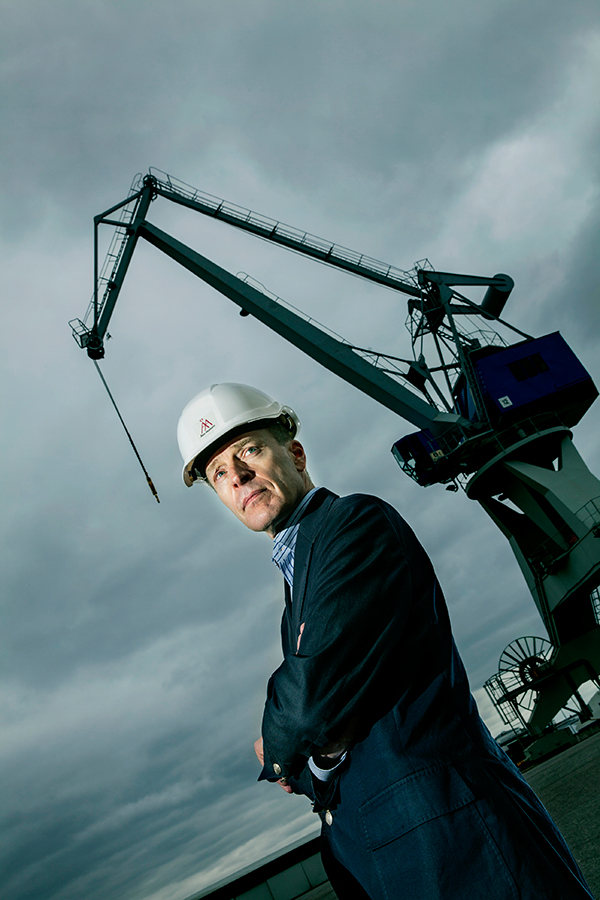Stricter limitations on the sulphur emissions coming from shipping came into force at the beginning of 2015, despite strong protests from the industry. A thorough makeover of the infrastructure of Finnish trade has begun in a project with international relevance.
Text: Nicklas Hägen
Trade is experiencing a fundamental change. The old, heavy transport industry based on, for example, paper, metal or minerals is decreasing. Instead, an industry has emerged which sends smaller amounts of material, but with an increased demand for shorter delivery times.
Traditional industrial systems have involved the transport of large streams of cargo that are highly predictable and thus easy to plan logistically. Smaller and more fragmented cargo streams place new demands along the entire transport chain, from producer to consumer.
All aspects of this industrial logistics process is now to be explored by a research consortium led by Åbo Akademi University and carried out in cooperation with Stanford University and the Kellogg School of Management in the USA. This is one of several projects on energy and the transport industry at the Laboratory for Industrial Management at Åbo Akademi University, and it will result in considerable changes in Finland’s infrastructure during the next 10–15 years.
Kim Wikström, Professor of Industrial Management at Åbo Akademi University does not hold his fire.
“We have a record number of ports in Finland; close to forty altogether. At least half of them should actually be closed,” says Wikström.
“Having many ports is an old tradition, but in our arctic conditions it’s an enormously expensive infrastructure to maintain. We have ports with expensive cranes and staff, and ships that arrive at them once a week.”
The project is of international relevance. The Baltic Sea and the English Channel will, from the beginning of 2015, be subject to the world’s strictest environmental regulations, with the main focus being on sulphur emissions. In the rest of the world the restrictions will come into force in 2020.
In order to comply with these limitations, the industry needs to rethink its processes. For example, the Finnish Transport Safety Agency, Trafi, has calculated that for the ships sailing to and from Finland, a conversion into low-sulphur fuel would entail an investment of 460–490 million euros. The corresponding sum would be 120–140 millions if all vessels were to install exhaust gas cleaning systems. These are very high costs and require extensive work.
“Our country has to work with extremely demanding logistical circumstances as well as the world’s strictest environmental regulations. Should we throw in the towel or see this as an opportunity? When my colleagues at Stanford heard about this they were galvanised. The same restrictions will be introduced elsewhere in 2020, so we have an advantage of five years. It’s a fantastic opportunity.”
“While solving our own country’s problems we expect this to also give us an extraordinary platform for innovations which will become part of a global industry. The Mediterranean, the west coasts of North and South America – there are numerous places with similar problems where we can export individual products, systems and organisational solutions.”
The objective is something similar to what the late Steve Jobs, the owner of Apple, did to the music industry: a total overhaul of old industrial segments.
“Energy and transport have often been regarded as an internal concern for the state, instead of a competitive advantage. This is what we aim to change. It could be said that we will explore an entire ecosystem, which from a theoretical perspective means that we’ll study information streams and material streams, and try to identify an ideal set of roles, asking the question of which actors are needed and who has the overall responsibility,” Wikström explains.
“We will look at technology, organisational solutions and the information flow from the production unit, the export industry and all the way to the final client. This includes land transport, ports, customs, shipping and handling at the end of the transport chain. We will investigate the entire system.”
A new boost
Finnish industry annually uses approximately 34 billion euros for transport, which corresponds to 10–12 per cent of the total cost structure of all enterprises. Shipping represents close to 90 per cent of all foreign trade and will therefore be the first aspect to be brought into focus.
Until a few years ago, Finland had a high position in the World Bank’s Logistics Performance Index, but now the country has fallen in the statistics from third to 24th place. The explanation behind this drastic drop is that the usage level of the infrastructure as a whole is as low as about 70 per cent. The average usage of the ships’ cargo capacity amounts to only 70 per cent, and the ships might be anchored in port for up to 40 per cent of their time of use. This is not reasonable, either from a financial or an environmental point of view.
According to Wikström, the problem is a lack of collaboration between the various parties involved. In order to bring about an improvement to the situation openness, transparency and new ICT solutions are needed.
Traditional ICT companies, such as Google or Facebook, have an administrator; a central actor that steers or controls the streams of information. Now the trend is to move from a centralised to a decentralised, friction-free information flow directly between users, and not through an administrator.
“A key to identifying solutions in logistics is to receive more exact information at an earlier stage and make correct analyses of it. This is an issue concerning big data.”
If the production industry at an early stage informs the relevant actors, such as ports, of what they intend to produce and when, it is easier to plan for that need. However, current logistical solutions are organised in a completely different fashion.
“Today, enterprises pass on their production information to their acquisitions department, which starts by finding land transport and perhaps opts for paying such a low price that the transport reaches the port more slowly than planned. The ship has sailed quickly in order to be able to load the cargo on Friday, but cannot do so and lies inactively waiting over the weekend while the crew accrue overtime,” says Wikström.
“These are simple and therefore perhaps difficult things to change, since all they actually require is a different attitude and an acceptance of the fact that certain actors are no longer a necessary part of the chain. This is where we must start.”
The project takes the form of a five-year collaborative undertaking between the research unit, the public sector and the industry, which will form the basis for an investment period of 10–15 years. It will involve all elements, including investments in new ships, issues pertaining to ports and establishing start-up companies within ICT.
“Our laboratory in industrial management is located in the field, within the companies. Our role is not only to give advice; we will also contribute to promoting change. We have already participated in negotiations on how the orders for new ships should be made,” says Wikström.
“Over the five years of the project, we will conduct pilot studies and create and implement solutions. We will collect observations, which make up the empirical material for our research. By analysing these we will create concepts, on the basis of tested results, which can be returned to the industry and also used in other contexts.
What kinds of new ships are needed?
“The macro trend is container traffic. Russia, for example, is constructing its infrastructure in order to receive goods from the West to St. Petersburg in containers. This is perfect when volumes are big. But when volumes are smaller, things are more complicated. The optimal delivery of smaller amounts of cargo requires bulk vessels, ro-ro ships with containers. There are various concepts involving feeder ships that sail in and berth halfway, while smaller vessels come and unload them. In addition, there are short sea ships for coastal traffic.”
“Ship owners are a breed who find it unbelievably difficult to cooperate. Their success has traditionally been based on each one developing their own strategies and competing with each other, but in crisis situations we need to join forces. Ship owners seem to enormously enjoy planning new vessels, and all of them think they are best in the world at it, which makes it impossible to create standard platforms. What is needed is a few ship owners who dare to apply the same concept to their vessels. That would mean lower unit costs, getting rid of prototypes and moving on to serial production. The ingredients can, of course, vary. In future, we can’t compete with technology, we must compete with intelligence and information flows.”
What characteristics are required of the ships?
“Smaller volumes and the various types of cargo place great demands on the holds. Two important issues are the emptying and cleaning of the holds – a common problem is that goods are contaminated by something that has previously been transported in the same cargo space. Speed is also a key aspect.”
“The part of a ship that makes money is the cargo space. The logistics company Cargotec is a key actor in delivering loading functions. They have already sold their first solutions to Korea, consisting of partition walls, washers and other solutions, as well as a certain level of automation. They don’t only deliver a product, but will also participate in the actual use of it. If Cargotec cooperates with 100–150 ship owners, it’s obvious that the amount of intelligence and statistics that they can gather will enable them to apply their knowledge to gaining a competitive advantage. By delivering a function instead of just a product, we can compete armed with knowledge. We try to convince the suppliers that they must be function-driven.”
“You should deliver a function in order to make money, and in order for the ship to be fully loaded so as not to make unnecessary demands on the environment, as well as to ensure the crew enjoys their work. When all these three aspects are included, shipping is sustainable.”
“We will develop a new model for shipbuilding; a network yard which doesn’t only involve one company, as is the case in traditional models. Here, a small group coordinates the construction. The rest is provided by suppliers. For example, the Finnish shipyard in Rauma has about 500 employees. According to our model, there would be 30–40 persons employed at the shipyard, while the rest come from companies such as Wärtsilä and Cargotec. This model is based on an organisational solution and shared responsibility. It’s impossible to provide a single ‘Great Innovation’.”
How has the form of trade changed transport systems in recent decades?
“Trade is not at a healthy level because of the way logistics are administered today. It’s not globally healthy to order tennis shoes from China or send salmon from Norway to China to be filleted and then back again to be eaten. This is untenable in the long run.”
What is the role of the internet in the changes? Don’t we tend to exaggerate its significance?
“No, many large chains have been surprised by the power of e-commerce. It has a massive impact on logistics. When you have a large department store where people come to shop, your material flows are much easier to handle than when all goods are delivered to the consumers’ homes.”
“Finding a solution to this is a very big question. The trend is that people want to be increasingly local. They understand that it’s impossible to send things back and forth across the world. Many countries have emphasized the environmental consequences of this, and many consumers protest by not wanting to buy food that is transported over distances that are too long. This is a key issue for us.”


